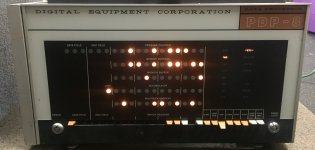m_thompson
Veteran Member
We cleaned lots of dust out of the system. Everything inside looks like it is in good condition.
I took the front panel apart to look at the switch paddles. It is really scary pulling out the really large and thin piece of glass for the front panel. Pivots are broken on 12 paddles, so I have some repair work to do. The momentary contact switch for START feels worn out. The PANEL LOCK switch was loose and rotated several turns which broke one of the wires.
I took a closer look at the processor clock modifications. It looks like they moved the R405 clock from the processor side and to the memory side. Then they wired the the clock signal through a one-shot and to a pulse amplifier that was installed in the original clock slot. I will make a schematic for the modified clock circuit.
I took the front panel apart to look at the switch paddles. It is really scary pulling out the really large and thin piece of glass for the front panel. Pivots are broken on 12 paddles, so I have some repair work to do. The momentary contact switch for START feels worn out. The PANEL LOCK switch was loose and rotated several turns which broke one of the wires.
I took a closer look at the processor clock modifications. It looks like they moved the R405 clock from the processor side and to the memory side. Then they wired the the clock signal through a one-shot and to a pulse amplifier that was installed in the original clock slot. I will make a schematic for the modified clock circuit.

